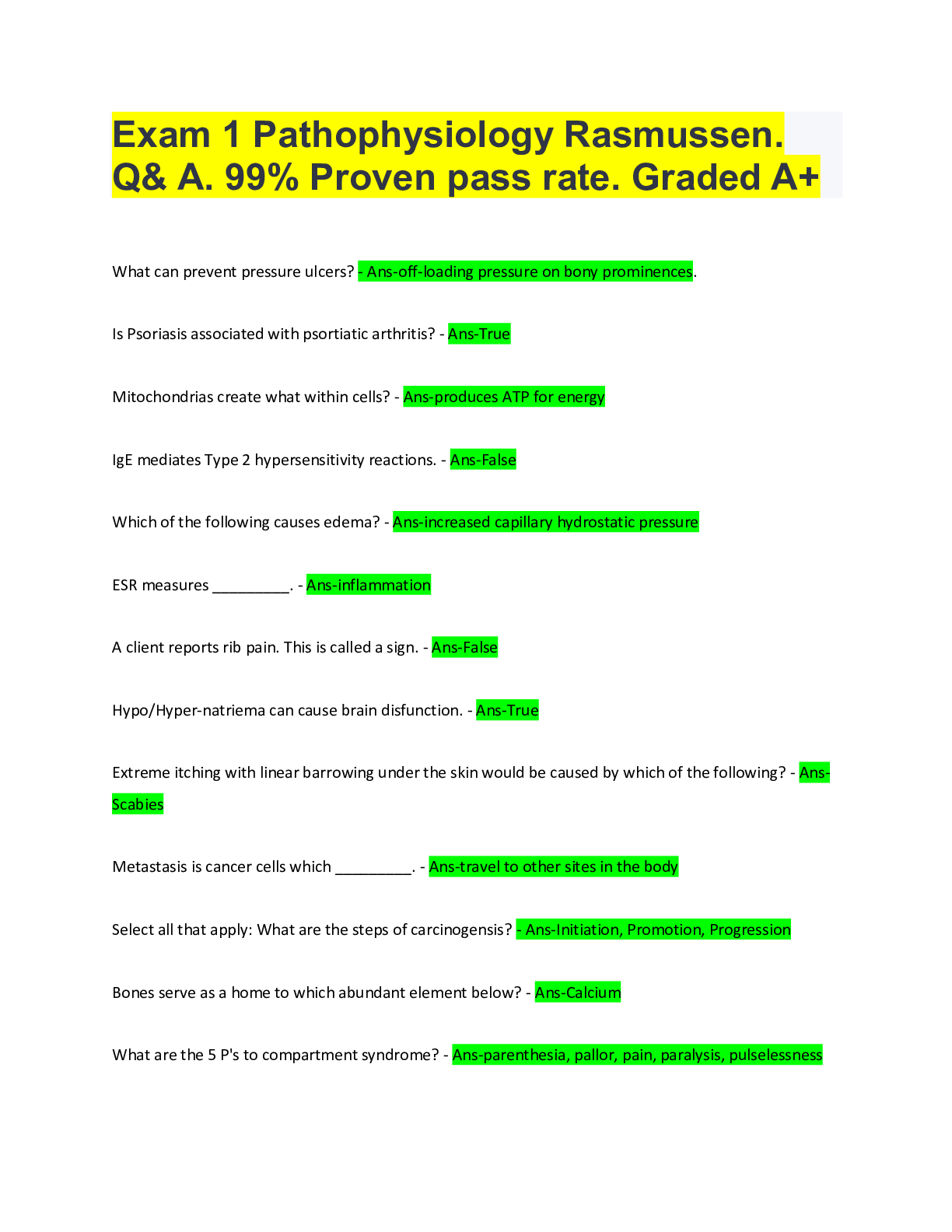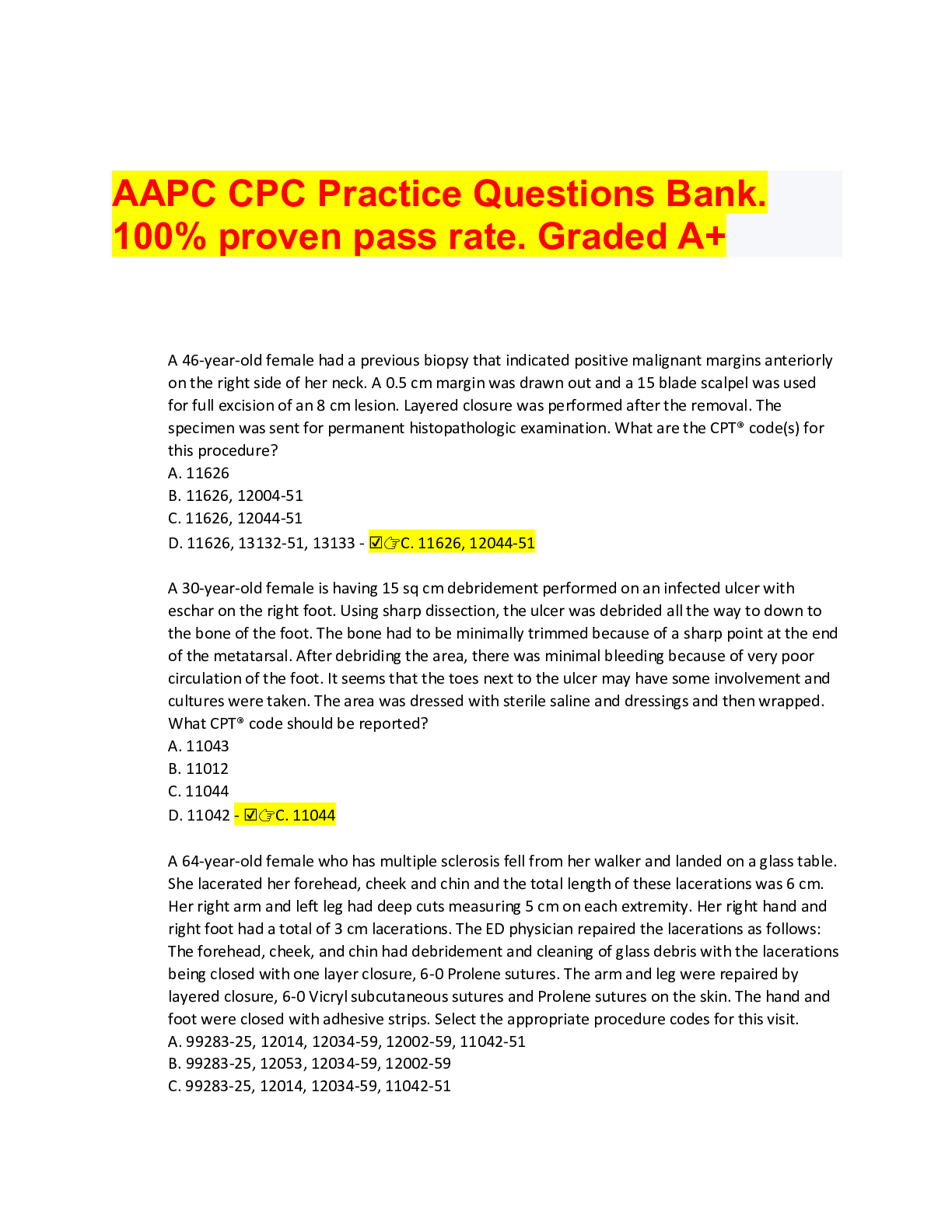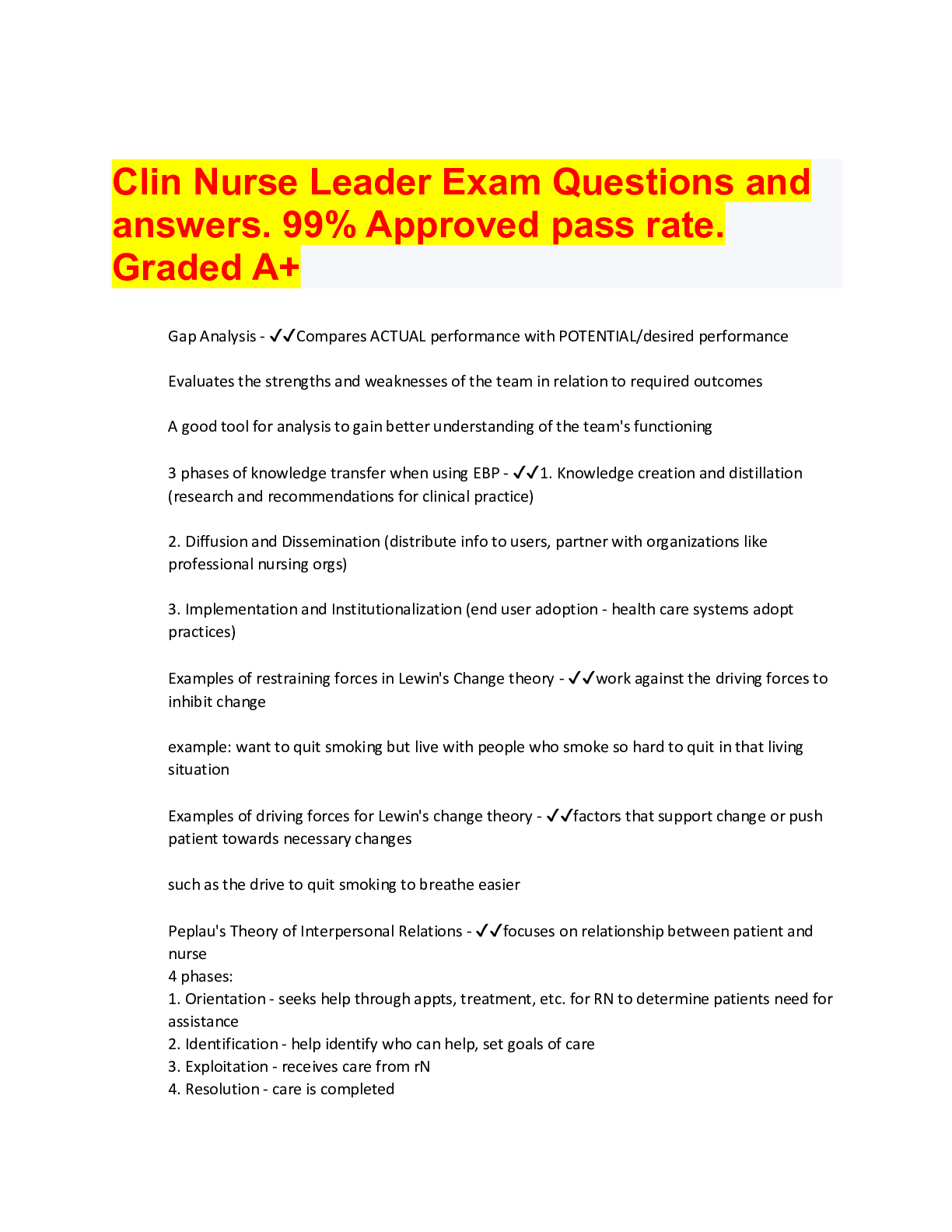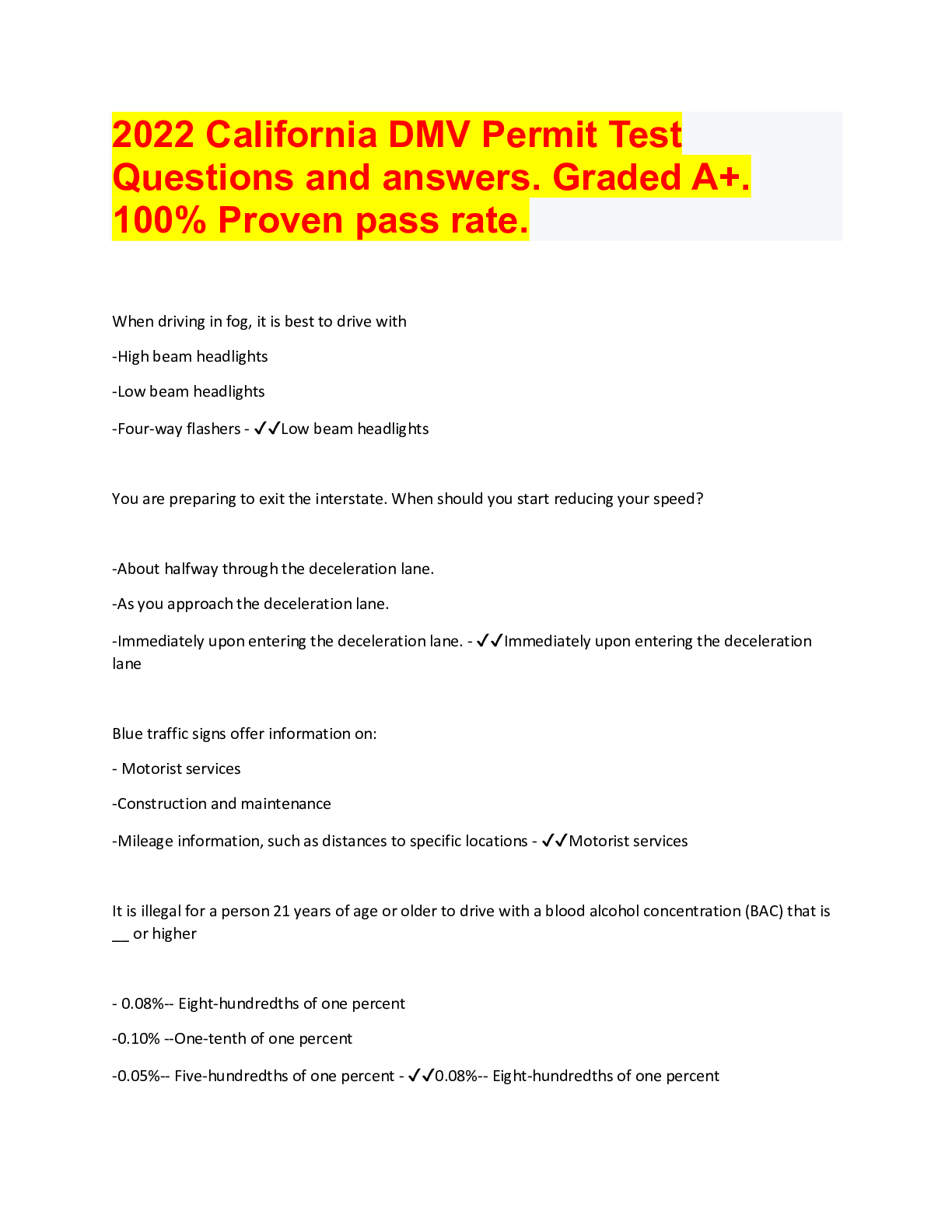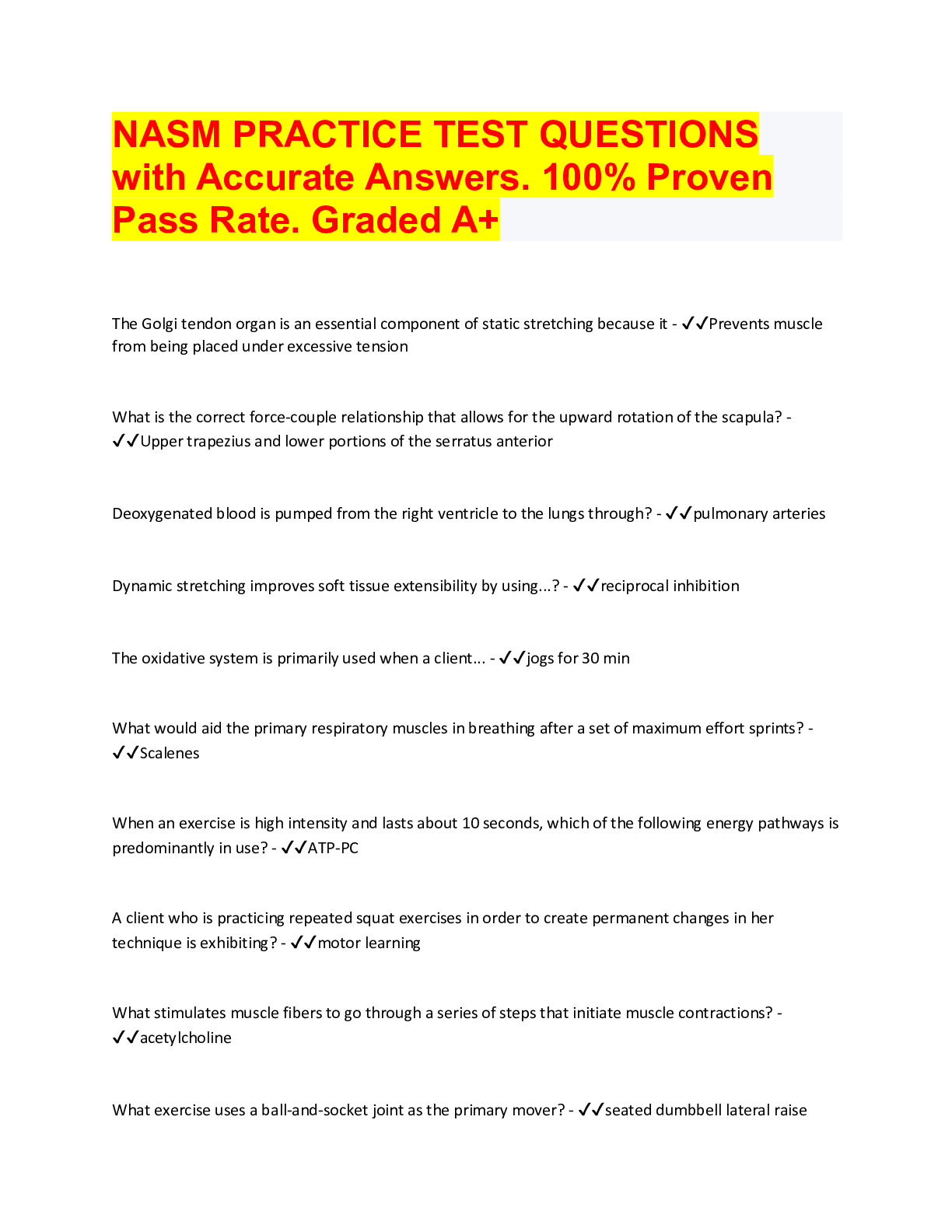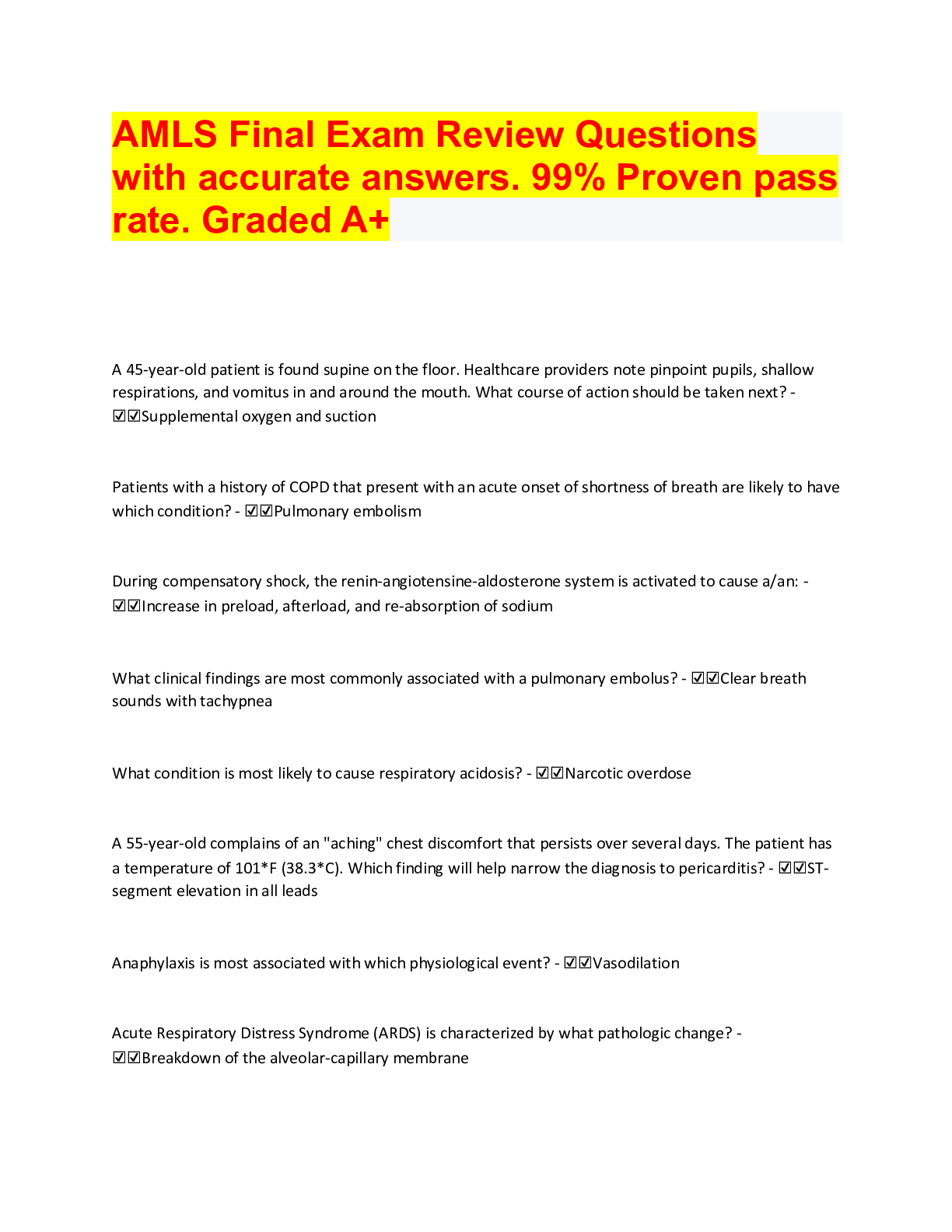Finance > QUESTIONS & ANSWERS > Full text financial management, Graded A+, 100% proven pass rate. Graded A+ (All)
Full text financial management, Graded A+, 100% proven pass rate. Graded A+
Document Content and Description Below
uiuua.pieefjdfp(MLOi0^pot.com Objective Questions and Answers of Financial Management 1. State whether each of the following statements is True (T) or False(F) (i) Financial statements are an impor... tant source of information to shareholders and stakeholders. (ii) Both the BS and the IS shows the financial position of fen at the end of the year. (ii) BS of a company must be prepared in the horizontal format only. (iv) Preparation of Profit & Loss Appropriation A/ c is a requirement under the Companies Act, 195 6. (v) Ratio Analysis is the only technique of analysis of financial statements. (vi) Methodical presentation of financial statements helps in Nation of various ratios. (vii) In Common Size Statements, each item is expressed as a percentage of some common items (tota l). (viii) Trend Percentage Analysis helps in Dynamic Analysis. (ix) Liquidity Ratios help in analysing the cash position of the firm. (x) In calculation of Acid Test Ratio, Inventory is included in current assets. (xi) Working Capital Turnover Ratio may be classified as an Activity Ratio. (xii) Debt-Equity Ratio is a measure of long-term solvency of a firm. (xiii) GP Ratio and NP Ratio give the profitability of the firm from the point of view of the shar eholders. (xiv) Return on Equity and Earnings per Share are one and the same thing. (xv) DU PONT Analysis looks into the elements of profits. (xvi) Ratio Analysis provides the solution to the financial problems. Answers: (i) T, (ii) F, (iii) F, (iv) F, (v) F, (vi) T, (vii) T, (viii) T, (ix) F, (x) F, (xi) T, (xii) T, (xiii) F, (xiv) F, (xv) T, (xvi) F.] 2. Multiple Choice Questions: 1. Accounting Ratios are important tools used by (a) Managers, (b) Researchers, (c)Investors, (d) All of the above 2. Net Profit Ratio Signifies:(a) Operational Profitability, (b) Liquidity Position,(c) Big-term S11/8/2019 Full text of "Financial Management MCQs with Answers" https://archive.org/stream/p-12_objective_questions_and_answers_of_financial_managementpk/p-12_objective_questions_and_answers_of_fin… 3/62 olvency, (d)Profit for Lenders. 3. Working Capital Turnover measures the relationship of Working Capital with: (a)Fixed Assets, (b)Sales,(c)Purchases,(d)Stock. 4. In Ratio Analysis, the term Capital Employed refers to: (a)Equity Share Capital, (b)Net worth, (c)Shareholders' Funds, (d)None of the above. 5. Dividend Payout Ratio is: (a)PAT Capital, (b)DPS EPS,(c) Pref. Dividend PAT, (d) Pref. Dividend Equity Dividend. 6. DU PONT Analysis deals with: (a) Analysis of Current Assets, (b)Analysis of Profit, (c)Capital Budgeting, (d) Analysis of Fixed Assets. 7. In Net Profit Ratio, the denominator is:(a)Net Purchases,(b)Net Sales, (c) Credit Sales, (d) Co st of goods sold. 8. Inventory Turnover measures the relationship of inventory with: (a) Average Sales, (b)Cost of Goods Sold, (c)Total Purchases, (d) Total Assets. 9. The term 'EVA' is used for: (a)Extra Value Analysis, (b)Economic Value Added, (c)Expected Value Analysis, (d)Engineering Value Analysis. 10. Return on Investment may be improved by: (a)Increasing Turnover, (b) Reducing Expenses, (c)Increasing Capital Utilization, (d) All of the a bove. 11. In Current Ratio, Current Assets are compared with: (a) Current Profit, (b) Current Liabilities, (c)Fixed Assets, (d)Equity Share Capital. 12. ABC Ltd. has a Current Ratio of 1.5: 1 and Net Current Assets of Rs. 5,00,000. What are the Cu rrent Assets? (a)Rs. 5,00,000, (b)Rs. 10,00,000, (c)Rs. 15,00,000, (d) Rs. 25,00,000 13. There is deterioration in the management of working capital of XYZ Ltd. What does it refer to? (a)That the Capital Employed has reduced, (b) That the Profitability has gone up,(c)That debtors c ollection period has increased, (d)That Sales has decreased. 14. Which of the following does not help to increase Current Ratio?11/8/2019 Full text of "Financial Management MCQs with Answers" https://archive.org/stream/p-12_objective_questions_and_answers_of_financial_managementpk/p-12_objective_questions_and_answers_of_fin… 4/62 (a)Issue of Debentures to buy Stock, (b)Issue of Debentures to pay Creditors, (c)Sale of Investmen t to pay Creditors, (d) Avail Bank Overdraft to buy Machine. 75. Debt to Total Assets Ratio can be improved by: (a)Borrowing More,(b)Issue of Debentures, (c)Issue of Equity Shares, (d)Redemption of Debt. 16. Ratio of Net Income to Number of Equity Shares known as: (a)Price Earnings Ratio, (b) Net Profit Ratio, (c)Earnings per Share, (d) Dividend per Share. 17. Trend Analysis helps comparing performance of a firm (a) With other firms, (b)Over a period of firm,(c)With other industries, (d) None of the above. 18. A Current Ratio of Less than One means: (a)Current Liabilities < Current Assets, (b)Fixed Assets > Current Assets, (c) Current Assets < Cu rrent Liabilities, (d) Share Capital > Current Assets. 19. A firm has Capital of Rs. 10,00,000; Sales of Rs. 5,00,000; Gross Profit of Rs. 2,00,000 and E xpenses of Rs. 1,00,000. What is the Net Profit Ratio? (a) 20%, (b) 50%,(c)10%, (d)40%. 20. XYZ Ltd. has earned 8% Return on Total Assests of Rs. 50,00,000 and has a Net Profit Ratio of 5%. Find out the Sales of the firm, (a) Rs. 4,00,000, (b)Rs. 2,50,000,(c)Rs. 80, 00,000, (d)Rs. 83,33,333. 21. Suppliers and Creditors of a firm are interested in(a)Profitability Position, (b)Liquidity Pos ition,(c)Market Share Position, (d) Debt Position. 22. Which of the following is a measure of Debt Service capacity of a firm? www.f^cebook.corn/pI<322 uiuua.pieefjdfp(MLOi0^pot.com (a)Current Ratio, (b)Acid Test Ratio, (c) Interest Coverage Ratio, (d) Debtors Turnover. 23. Gross Profit Ratio for a firm remains same but the Net Profit Ratio is decreasing. The reason for such behavior could be:11/8/2019 Full text of "Financial Management MCQs with Answers" https://archive.org/stream/p-12_objective_questions_and_answers_of_financial_managementpk/p-12_objective_questions_and_answers_of_fin… 5/62 (a) Increase in Costs of Goods Sold, (b)If Increase in Expense, (c) Increase in Dividend, (d) Decr ease in Sales. 24. Which of the following statements is correct? (a) A Higher Receivable Turnover is not desirable, (b) Interest Coverage Ratio depends upon Tax Ra te, (c) Increase in Net Profit Ratio means increase in Sales, (d) Lower Debt-Equity Ratio means lower Financial Risk. 25. Debt to Total Assets of a firm is .2. The Debt to Equity boo would be: (a) 0.80, (b)0.25, (c) 1.00, (d)0.75 26. Which of the following helps analysing return to equity Shareholders? (a) Return on Assets, (b) Earnings Per Share, (c) Net Profit Ratio, (d)Return on Investment. 27. Return on Assets and Return on Investment Ratios belong to: (a) Liquidity Ratios,(b)Profitability Ratios, (c)Solvency Ratios,(d)Turnover. 28. XYZ Ltd. has a Debt Equity Ratio of 1.5 as compared to 1.3 Industry average. It means that the firm has: (a) Higher Liquidity, (b)Higher Financial Risk,(c)Higher Profitability, (d)Higher Capital Employe d. 29. Ratio Analysis can be used to study liquidity, turnover, profitability, etc. of a firm. What d oes Debt-Equity Ratio help to study? (a) Solvency, (b) Liquidity, (c) Profitability, (d) Turnover, 30. In Inventory Turnover calculation, what is taken in the numerator? (a) Sales, (b)Cost of Goods Sold,(c)Opening Stocked) Closing Stock. [Answers : 1. (d); 2. (a) 3. (a); 4. (d); 5. (b); 6. (b); 7. (b); 8. (b); 9. (b); 10. (d); 11. (b); 12. (c); 13. (c); 14. (d); 15. (d); 16. (c); 17. (b); 18. (c);19. (a); 20. (c);21. (b);22. (c);23. (b);24. (d);25. (b);26. (b); 27. (b); 28. (b); 29. (a); 30. (b)]. 3. State whether each of the following statements is True (T) or False(F) (i) Financial Planning deals with the preparation of financial statements. (ii) Cash planning is a part of long-term financial planning. (iii) Financial forecasting is followed by financial planning.11/8/2019 Full text of "Financial Management MCQs with Answers" https://archive.org/stream/p-12_objective_questions_and_answers_of_financial_managementpk/p-12_objective_questions_and_answers_of_fin… 6/62 (iv) Budgeting helps in establishing the responsibilities at different levels. (v) A budget is a collation of forecasts and plans expressed in financial terms. (vi) Cash budget is also known as Master Budget. (vii) Sales and Production Budgets are Capital Budgets. (viii) Rolling Budget System, budget for every month is prepared. (ix) Cash budget is an important element of profit planning. (x) Financial planning is incomplete without cash budget. (xi) Projected Financial Statements are prepared on the basis of opening financial statements. (xii) Projected Financial Statements can be prepared only if several other budgets are available. (xiii) There is no assumption required for the preparation of projected financial statements. (xiv) Percentage of Sales method can be used to prepare both the PIS and PBS. [Answers: (i) F, (ii) F, (iii) T, (iv) T, (v) T, (vi) F, (vii) F, (viii) F, (ix) F, (x) T, (xi) F, (xii) T, (xiii) F, (xiv) T] 4. Multiple choice questions 1. Financial Planning deals with: (a) Preparation of Financial Statements, (b)Planning for a Capit al Issue, (c) Preparing Budgets, (d)All of the above. 2. Financial planning starts with the preparation of: (a) Master Budget, (b) Cash Budget, (c) Bala nce Sheet, (d) None of the above. 3. Which of the following is not a part of Master Budget? (a)Projected Balance Sheet,(b) Capital Expenditure Budget, (c)Operating Budgets, (d) Budget Manua l. 4. Which of the following is not shown in Cash Budget? (a)Proposed Issue of Capital, (b) Loan Repayment, (c) Interest on loan,(d) Depreciation. 5. During year 1, the sales and Cost of goods sold were Rs. 6,00,000 and Rs. 4,30,000 respectivel y. Next year, the sales are expected to increase by 10%. The Cost of goods sold for next year would be: (a) Rs. 4, 30,000, (b) Rs. 4,90,000, (c) Rs. 4, 73,000, (d) Rs. 4,40,000. 6. In 'Percentage of Sales' method of preparation of Projected Financial Statements, the Operating Expenses11/8/2019 Full text of "Financial Management MCQs with Answers" https://archive.org/stream/p-12_objective_questions_and_answers_of_financial_managementpk/p-12_objective_questions_and_answers_of_fin… 7/62 should be projected on the basis of: (a) % of Profit before tax, (b) % of Cost of goods Sold, (c) % of Gross Profit, (d) % of Sales. 7. In'% of Sales' method, various items of balance sheet are estimated on the basis of. (a) % of Share Capital, (b) % of Sales in current year, (c) % of Fixed Assets, (d) % of Sales in p receding year. 8. In Projected Balance Sheet, a balancing figure: (a) May appear on Assets Side,(b) May appear on Liabilities Side,(c) Would never appeared) Any of (a) or (&). 9. Procedure for preparation of 'Projected Financial Statements' should start from: (a) Projection of Fixed Assets,(b) Projection of Capital, (c) Projection of Sales, (d) Projection of Profit. 10. Which of the following is not considered which preparing cash budget? (a) Accrual Principle, (b) Difference in Capital, and Revenue items, (c) Conservation Principle, (d) All of the above. 11. Which of the following may not be apart of projected Financial Statements? (a) Projected Income Statement, (b) Projected Trial Balance, (c) Projected Cash Flow Statement, (d) Projected Balance Sheet. 12. Process of Financial Planning ends with: www.fecebook.com/pI<322 uiuua.pieefjdfp(MLOi0^pot.com (a) Preparation of Projected Statements, (b) Preparation of Actual Statements, (c) Comparison of A ctual with Projected, (d) Ordering the employees that projected figures m come true. 13. Which of the following is not true for cash Budge? (a) That shortage or excess of cash would appear in a particular period, (b) All inflows would ari se before outflows for those periods, (c) Only revenue nature cash flows are shown. (d) Proposed issue of sh are capital in11/8/2019 Full text of "Financial Management MCQs with Answers" https://archive.org/stream/p-12_objective_questions_and_answers_of_financial_managementpk/p-12_objective_questions_and_answers_of_fin… 8/62 shown as an inflow. [Answers: 1. (c); 2. (d); 3. (d); 4. (d); 5. (c); 6. (d); 7. (d), 8 (d), 9. (c); 10. (d); 11. (b); 12. (c); 13. (c)] 5. State whether each of the following statements is True (T) or False (F): (i) Investment decisions and capital budgeting are same. (ii) Capital budgeting decisions are long term decisions. (iii) Capital budgeting decisions are reversible in nature. (iv) Capital budgeting decisions do not affect the future Stability of the firm. (v) There is a time element involved in capital budgeting. (vi) An expansion decision is not a capital budgeting decision (vii) In mutually exclusive decision situation, the firm can accept all feasible proposals. (viii) Capital budgeting and capital rationing are alternative to each other. (ix) Correct capital budgeting decisions can be taken by comparing the cost with future benefits. (x) Future expected profits from an investments are taken as returns from the investment for capit al budgeting. (xi) Cash flows are the appropriate measure of costs and benefits from an investment proposal. (xii) Sunk cost is a relevant cost in capital budgeting. (xiii) The opportunity cost of an input is always considered, in capital budgeting. (xiv) Allocated overhead costs are not relevant for capital budgeting. (xv) Cash flows and accounting profits are different. (xvi) Cash flows are same as profit before tax. (xvii) Net cash flow is on after tax basis. [Answers : (i) F, (ii) T, (iii) F, (iv) F, (v) T, (vi) F, (vii) F, (viii) F, (ix) F, (x) F, (xi) T, (xii) F, (xiii) F, (xiv) T, (xv) T, (xvi)F, (xvii) T 6. Multiple choice questions 1. Capital Budgeting is a part of: (a)Investment Decision, (b) Working Capital Management, (c) Mar keting Management, (d) Capital Structure. 2. Capital Budgeting deals with:(a) Long-term Decisions, (b) Short-term Decisions, (c) Both (a) an11/8/2019 Full text of "Financial Management MCQs with Answers" https://archive.org/stream/p-12_objective_questions_and_answers_of_financial_managementpk/p-12_objective_questions_and_answers_of_fin… 9/62 d (b),(d) Neither (a) nor (b). 3. Which of the following is not used in Capital Budgeting? (a) Time Value of Money, (b) Sensitivity Analysis, (c) Net Assets Method, (d) Cash Flows. 4. Capital Budgeting Decisions are: (a) Reversible, (b) Irreversible, (c) Unimportant, (d) All of the above. 5. Which of the following is not incorporated in Capital Budgeting? (a) Tax-Effect, (b) Time Value of Money,(c) Required Rate of Returned) Rate of Cash Discount. 6. Which of the following is not a capital budgeting decision? (a) Expansion Programme, (b) Merger, (c) Replacement of an Asset, (d) Inventory Level. 7. A sound Capital Budgeting technique is based on: (a) Cash Flows, (b)Accounting Profit, (c) Interest Rate on Borrowings, (d) Last Dividend Paid. 8. Which of the following is not a relevant cost in Capital Budgeting? (a) Sunk Cost,(b) Opportunity Cost,(c) Allocated Overheads, (d) Both (a) and (c) above. 9. Capital Budgeting Decisions are based on: (a) Incremental Profit, (b) Incremental Cash Flows, (c) Incremental Assets, (d) Incremental Capita l. 10. Which of the following does not effect cash flows proposal? (a) Salvage Value, (b) Depreciation Amount, (c) Tax Rate Change,(d) Method of Project Financing. 11. Cash Inflows from a project include: (a) Tax Shield of Depreciation, (b) After-tax Operating Profits, (c) Raising of Funds, (d) Both (a) and (b). 12. Which of the following is not true with reference capital budgeting? (a) Capital budgeting is related to asset replacement decisions, (b) Cost of capital is equal to m inimum required return, (c) Existing investment in a project is not treated as sunk cost,(d) Timing of cash flows is relevant. 13. Which of the following is not followed in capital budgeting? (a) Cash flows Principle, (b) Interest Exclusion Principle, (c) Accrual Principle, (d) Post-tax Pr inciple.11/8/2019 Full text of "Financial Management MCQs with Answers" https://archive.org/stream/p-12_objective_questions_and_answers_of_financial_managementpk/p-12_objective_questions_and_answers_of_fi… 10/62 14. Depreciation is incorporated in cash flows because it: (a) Is unavoidable cost,(b) Is a cash flow,(c) Reduces Tax liability, (d) Involves an outflow. 15. Which of the following is not true for capital budgeting? (a) Sunk costs are ignored, (b)Opportunity costs are excluded, (c)Incremental cash flows are consi dered, (d) Relevant cash flows are considered. 16. Which of the following is not applied in capital budgeting? (a) Cash flows be calculated in incremental terms, (b) All costs and benefits are measured on cash basis, (c) All accrued costs and revenues be incorporated, (d) All benefits are measured on after-tax bas is. 17. Evaluation of Capital Budgeting Proposals is based on Cash Flows because: (a) Cash Flows are easy to calculate, (b)Cash Flows are suggested by SEBI, (c) Cash is more import ant than profit, (d) None of the above. 18. Which of the following is not included in incremental A flows? www.f^cebook.corn/pI<322 uiuua.pieefjdfp(MLOi0^pot.com (a) Opportunity Costs, (b)Sunk Costs, (c) Change in Working Capital, (d) Inflation effect. 19. A proposal is not a Capital Budgeting proposal if it: (a) is related to Fixed Assets,(b) brings long-term benefits, (c) brings short-term benefits only, (d) has very large investment. 20. In Capital Budgeting, Sunk cost is excluded because it is: (a) of small amount, (b) not incremental, (c) not reversible, (d) All of the above. 21. Savings in respect of a cost is treated in capital budgeting as: (a) An Inflow, (b) An Outflow, (c) Nil, (d) None of the above. [Answers : 1(a), 2(a), 3(c), 4(b), 5(d), 6(d), 7(a), 8(d), 9(b), 10(d), 11(d), 12(c), 13 (c), 1411/8/2019 Full text of "Financial Management MCQs with Answers" https://archive.org/stream/p-12_objective_questions_and_answers_of_financial_managementpk/p-12_objective_questions_and_answers_of_fi… 11/62 (c), 15(b), 16(c), 17(c), 18(b), 19(c), 20(b), 21(a)] 7. State whether each of the following statement is True (T) or False (F): (i) Irrespective of the issue involved in a capital budgeting anon, the basic techniques can be us ed in all cases. (ii) Capital Rationing as a situation when the Government has imposed a ceiling on investment by a firm. (iii) A firm should always implement a positive NPV props irrespective of fund requirement. (iv) Money cash flows should be discounted at nominal discount rate. (v) Real cash flows should be discounted at normal discount rate. (vi) EAM is, in a way, an extension of NPV method. (vii) EAM should be used in accept-reject decision situation. (viii) Feasibility Set Approach is based on the NPV method of capital budgeting. (ix) Selection based on PI method gives optimum decision making in case of indivisible projects. (x) A firm should ignore the replacement timing of an asset. (xi) There is no need to defer a positive NPV proposal. (xii) Multi-period and Multi-constraints are one and the same thing. (xiii) Inflation affects not only the cash flows but also the discount rate. Answers: (i) F, (ii) F, (iii) F, (iv) T, (v) T, (vi) T, (vii) F (viii) T, (ix) F, (x) F, (xi) F, (xii) F, (xiii) T 8. Multiple Choice Questions: 1. In capital budgeting, the term Capital Rationing implies: (a) That no retained earnings available, (b) That limited funds are available for investment, (c) That no external funds can be raised, (d) That no fresh investment is required in current year 2. Feasibility Set Approach to Capital Rationing can be applied in: (a) Accept-Reject Situations, (b) Divisible Projects, (c) Mutually Exclusive Projects, (d) None of the above 3. In case of divisible projects, which of the following can be used to attain maximum NPV? (a) Feasibility Set Approach, (b) Internal Rate of Return, (c) Profitability Index Approached) Any of the above11/8/2019 Full text of "Financial Management MCQs with Answers" https://archive.org/stream/p-12_objective_questions_and_answers_of_financial_managementpk/p-12_objective_questions_and_answers_of_fi… 12/62 4. In case of the indivisible projects, which of the following may not give the optimum result? (a) Internal Rate of Return, (b) Profitability Index, (c) Feasibility Set Approach, (d) All of the above 5. Profitability Index, when applied to Divisible Projects, impliedly assumes that: (a) Project cannot be taken in parts, (b) NPV is linearly proportionate to part of the project tak en up,(c) NPV is additive in nature, (d) Both (b) and (c) 6. If there is no inflation during a period, then the Money Cashflow would be equal to: (a) Present Value, (b) Real Cashflow, (c) Real Cashflow + Present Value , (d) Real Cashflow - Pres ent Value 7. The Real Cashflows must be discounted to get the present value at a rate equal to: (a) Money Discount Rate,(b) Inflation Rate,(c) Real Discount Rate,(d) Risk free rate of interest 8. Real rate of return is equal to: (a) Nominal Rate x Inflation Rate, (b) Nominal Rate Inflation Rate,(c) Nominal Rate - Inflation Ra te,(d) Nominal Rate + Inflation Rate 9. If the Real rate of return is 10% and Inflation s Money Discount Rate is: (a) 14.4%, (b) 2.5%,(c) 25%, (d) 14% 10. If the Money Discount Rate is 19% and Inflation Rate is 12%, then the Real Discount Rate is: (a) 7%,(b) 5%, (c) 5.70%,(d) 6.25% 11. Money Discount Rate if equal to: (a) (1 + Inflation Rate) (1 + Real Rate)-1, (b) (1 + Inflation Rate) 4- (1 + Real Rate)-1, (c) (1 + Real Rate) 4- (1 + Inflation Rate)-1, (d) (1 + Real Rate) + (1 + Inflation Rate)-1 12. Real Discount Rate is equal to: (a) (1 + Inf. Rate) (1 + Money D Rate)-1, (b) (1 + Money D Rate) + (1 + Inf. Rate)-1, (c) (1 + Money D Rate) 4- (1 + Inf. Rate)-1, (d) (1 + Money D Rate) - (1 + Inf. Rate)-1 13. Which of the following cannot be true? (a) Inflation Rate > Money Dis. Rate,(b) Real Dis. Rate < Money Dis. Rate (c) Inflation Rate < Real Dis. Rate, (d) Inflation Rate = Real Dis. Rate 14. Money Cash flows should be adjusted for:11/8/2019 Full text of "Financial Management MCQs with Answers" https://archive.org/stream/p-12_objective_questions_and_answers_of_financial_managementpk/p-12_objective_questions_and_answers_of_fi… 13/62 (a) Only Inflation Effect, (b) Only Time Value of Money,(c) None of (a) and (b),(d) Both of (a) an d (b) 15. EAV should be used in case of: (a) Divisible Projects, (b) Repetitive Projects, (c) One-off In vestments ; (d) Indivisible Projects 16. EAV is Equal to: (a) NPV x PVAF (r , n) , (b) NPV + PVAF (r , n) , (c) NPV - PVAF (r , n )(d), NPV-PVAF (r , n ) 17. If a project has positive NPV, its EAV is (a) Equal to NPV, (b)More than NPV,(c) Less than NPV,(d) Any of the above 18. Two mutually exclusive projects with different economic lives can be compared on the basis of (a) Internal Rate of Return, (b) Profitability Index, (c) Net Present Value, (d) Equivalent Annuit y Value www.f^cebook.corn/pI<322 uiuua.pteef}dfp(Mt.Oi0^pot.com [Answers: 1. (b); 2. (a); 3. (c); 4. (c); 5. (d); 6. (b); 7. (c); 8. (b); 9. (a); 10. (d);ll. (a); 12. (c); 13. (a); 14. (c); 15. (b);16. (c);17.(c);18. (d)] 19. Write her each of the following statement is True (T) or False (F) (i) A risky situation is one in which the probability for the occurrence or non-occurrence of an e vent cannot be assigned. (ii) In capital budgeting proposals, risk may arise due to different factors. (iii) In risky capital budgeting proposals, the discount rate is not known with certainty. (iv) Risk Adjusted Discount Rate and Certainty Equivalents are on based statistical measures. (v) In Payback Period method, the risk of the proposal is incorporated by lessening the target pay back period. (vi) In Certainty Equivalents method, both the cashflows and the discount rate are adjusted. (vii) In Sensitivity Analysis, the NPV of the proposal is adjusted. (viii) In Sensitivity Analysis, one variable is adjusted at a time to see its effect on the NPV.11/8/2019 Full text of "Financial Management MCQs with Answers" https://archive.org/stream/p-12_objective_questions_and_answers_of_financial_managementpk/p-12_objective_questions_and_answers_of_fi… 14/62 (ix) Sensitivity Analysis helps in calculation of NPV of the proposal. (x) Expected value of cash flows is equal to the arithmetic average of the cash flows. (xi) In case of capital budgeting, higher the standard deviation better the project is. (xii) In case of dependent cash flows, the risk is measured with reference to joint probabilities. (xiii) Coefficient of variation is as good a measure of risk as the standard deviation. (xiv) Decision Tree Approach is suitable to analyse a multistage decision situation. (xv) Abandonment evaluation of a project is ma the implementation of a capital budgeting proposal. [Answers: (i) F, (ii) T, (iii) F, (iv) F, (v) T, (vi) F, (vii F,(viii) F, (ix) F, (x) F, (xi) F, (xii) T, (xiii) F, (xiv) T, (xv) F] 20. Multiple Choice Questions 1. Risk in Capital budgeting implies that the decision-maker knows of the cash flows. (a) Variability, (b) Probability, (c) Certainty, (d) None of the above 2. In Certainty-equivalent approach, adjusted cash flows are discounted at: (a) Accounting Rate of Return, (b) Internal Rate of Return, (c) Hurdle Rate,(d) Risk-free Rate 3. Risk in Capital budgeting is same as: (a) Uncertainty of Cash flows,(b) Probability of Cash flows, (c) Certainty of Cash flows, (d) Vari ability of Cash flows 4. Which of the following is a risk factor in capital budgeting? (a) Industry specific risk factors, (b) Competition risk factors, (c) Project specific risk factor s, (d) All of the above 5. In Risk-Adjusted Discount Rate method, the normal rate of discount is: (a) Increased, (b) Decreased, (c) Unchanged, (d) None of the above 6. In Risk-Adjusted Discount Rate method, which one is adjusted? (a) Cash flows,(b) Life of the proposal, (c) Rate of discounted) Salvage value 7. NPV of a proposal, as calculated by RADR real CE Approach will be: (a) Same,(b) Unequal, (c) Both (a) and (b),(d) None of (a) and (b) 8. Risk of a Capital budgeting can be incorporated11/8/2019 Full text of "Financial Management MCQs with Answers" https://archive.org/stream/p-12_objective_questions_and_answers_of_financial_managementpk/p-12_objective_questions_and_answers_of_fi… 15/62 (a) Adjusting the Cash flows, (b) Adjusting the Discount Rate,(c) Adjusting the life, (d) All of t he above 9. Which element of the basic NPV equation is adjusted by the RADR? (a) Denominator, (b) Numerator, (c) Both,(d) None 10. In CE Approach, the CE Factors for different years are: (a) Generally increasing, (b) Generally decreasing, (c) Generally same,(d) None of the above 11. Which of the following is correct for RADR? (a) Accept a project if NPV at RADR is negative, (b) Accept a project if IRR is more than RADR (c) RADR is overall cost of capital plus risk-premium , (d) All o f the above. 12. In Playback Period approach to risk the target payback period is (a)Not adjusted, (b)Adjusted upward, (c) Adjusted downward , (d) (b) or c 13. In Sensitivity Analysis, the emphasis is on assessment of sensitivity of (a) Net Economic Life, (b) Net Present Value, (c) Both (a) and (b), (d)None of (a) and (b) 14. Most Sensitive variable as given by the Sensitivity Analysis should be: (a) Ignored, (b) Given Least important, (c) Given the maximum importance, (d) None of the above 15. Expected Value of Cashflow, EVCF, is: (a) Certain to occur, (b) Most likely Cashflows,(c) Arit hmetic Average Cashflow, (d) Geometric Average Cashflow 16. Concept of joint probability is used in case of: (a) Independent Cashflows,(b) Uncertain Cashflows, (c) Dependent Cashflows,(d) Certain Cashflows 17. Decision-tree approach is used in: (a) Proposals with longer life, (b) Sequential decisions, (c) Independent Cashflows, (d) Accept-Re ject Proposal [Answers : 1. (b) 2. (d) 3. (d) 4. (d) 5. (a) 6. (c) 7. (b) 8. (d) 9. (a) 10. (b). 11. (c) 12. (c) 13. (b) 14. (c) 15. (b) 16. (c) 17. (b) ] 21. State whether each of the following statements is True (T) or False (F): (i) The cost of capital is the required rate of return to certain the value of the firm. (ii) Different sources of funds have a specific cost of capital related to that source only. (iii) Cost of capital does not comprise any risk premium.11/8/2019 Full text of "Financial Management MCQs with Answers" https://archive.org/stream/p-12_objective_questions_and_answers_of_financial_managementpk/p-12_objective_questions_and_answers_of_fi… 16/62 (iv) Cost of capital is basic data for NPV technique. (v) Risk free interest rate and cost of capital are same things. (vi) Different sources have same cost of capital. (vii) Tax liability of the firm is relevant for cost of capital of all the sources of funds. (viii) Cost of debt and Cost of Pref. share capital, both, require tax adjustment. [Show More]
Last updated: 2 years ago
Preview 1 out of 62 pages

Buy this document to get the full access instantly
Instant Download Access after purchase
Buy NowInstant download
We Accept:

Reviews( 0 )
$8.00
Can't find what you want? Try our AI powered Search
Document information
Connected school, study & course
About the document
Uploaded On
Aug 29, 2022
Number of pages
62
Written in
Seller

Reviews Received
Additional information
This document has been written for:
Uploaded
Aug 29, 2022
Downloads
0
Views
92











